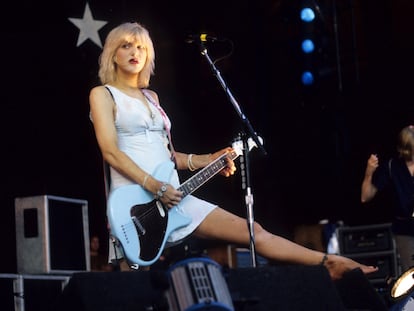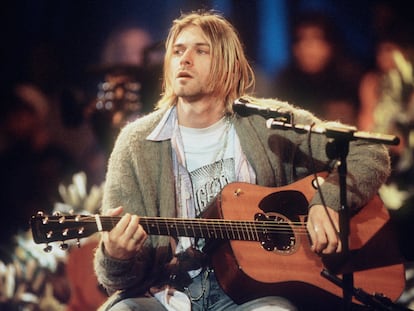On the trail of Nirvana 30 years after Kurt Cobain’s death
Artists and critics establish that the mystical influence of the unique band is very much alive as they examine how it changed rock history and left a spiritual legacy
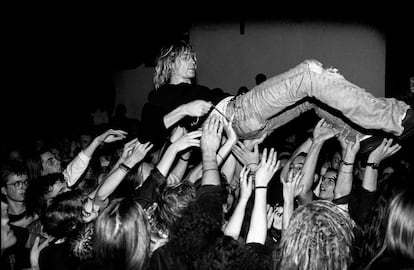
In the film loosely based on Kurt Cobain’s final hours, Last Days, by Gus Van Sant (2005), there is a strange allegorical sequence. When an electrician discovers the corpse, a naked, spectral body emerges from it and rises — an illustration of how, on April 8, 1994, when Cobain’s body was found three days after his demise, the man died and the myth was born.
Thirty years later, it might be said that Nirvana is still the last great classic rock band. But not just because of their iconic achievements — most visibly, dethroning Michael Jackson from No. 1 in the U.S. charts and making so-called alternative rock hegemonic in the early 1990s — or even because their frontman shot himself when he was just 27. “I’m sure the way Kurt passed away has a kind of appeal to some people, but it’s not a key component of the group’s legacy,” explains music critic Michael Azarrad, author of Come As You Are: The Story of Nirvana and co-producer of the documentary Kurt Cobain: About A Son (2006). “Even when Nirvana existed, everyone knew they would be legendary. They were a great band that played great songs that evoked deep, powerful, complicated feelings that no one had articulated before. That kind of thing tends to last.”
Paco Pérez Bryan, who kept the whole of Spain informed about Nirvana’s career as it unfolded on his program De 4 a 3, on Radio 3, agrees. “Their album Nevermind was already part of music history, even though Cobain’s death shocked us all,” he says. “Nevermind was unique. Every time I played it, I got the kind of feedback you can get from a medium like radio in a time that predated streaming: so, I knew that thousands of listeners were enjoying it along with me.”
Pérez Bryan recalls the first time he saw the group play: “I saw them live in London, at the National Kilburn Ballroom,” he says. “I was lucky enough to see lots of concerts but that night sent shockwaves through the world of rock and roll. All the ingredients came together, such as rebelliousness and wild energy. Years later I saw them again in Honolulu the day before Cobain’s wedding to Courtney Love and it still seemed as outrageous as the first time.” A young fan from Madrid named Amparo Llanos was also at that gig. The experience changed her life, leading she and her sister Cristina to form Dover, the best-selling Spanish alternative rock band of the 1990s.
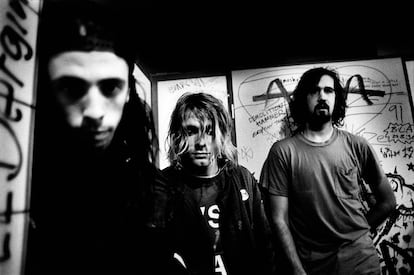
Everyone talks about the Seattle band’s energy and attitude, their melodies and lyrics, but there are other less obvious factors that made their influence decisive. “I think they showed it was possible to make music another way, beyond the cool, flirty, rock star macho guy thing that was so fashionable at the time with Guns N’ Roses and Mötley Crüe, etc. For the first time, there was a certain interest in issues such as equality and feminism” explains Anxela Baltar, vocalist and guitarist from the Galician group Bala, who was 10 when Kurt Cobain died, after which she became obsessed with his music. “There’s another thing I owe them and that changed my life: it was due to Nirvana that I found the riot grrrl [feminist punk movement], which they were very connected to. And that opened up a whole new world of absolutely unknown examples of girls doing things they weren’t supposed to do.”
Nirvana also influenced Spanish-American singer-songwriter Irene Tremblay, who claimed notoriety on the Spanish indie scene with her three Aroah albums and three EPs released between 2001 and 2007. She even sang a version of Smells Like Teen Spirit with which she opened her tribute album to Nevermind, released by the bosses of La isla de encanta radio show in 2011. Tremblay was 11 when the original album was released. “It was the beginning of everything as far as I was concerned,” she says. “It was the first time I saw music as a form of self-expression, beyond entertainment. I also think for someone young who has a real passion for music it can be a great discovery, because of the timeless quality of Cobain’s songs. If they were released now, I think they would have done just as well. They would be heard on today’s media and they would sound very different, but maybe with the same energy and knowledge of the world that young people share.”
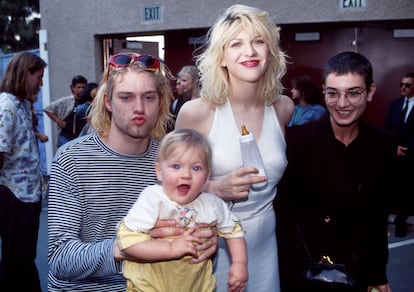
All the critics and artists interviewed agree that Nirvana’s influence on today’s music scene is more spiritual than anything directly copycat. “When Nirvana became massive, the record industry did what they always do: they signed a lot of artists who sounded like them,” says Azerrad. “Those bands started to fade away in the late 1990s, and then something else happened: a new generation of musicians were inspired by Nirvana without sounding like them, and that’s an excellent legacy. The basic idea — playing heartfelt music — can manifest itself in many ways, and I see it in M.I.A., Lil Wayne, Lana del Rey, Dirty Projectors, the late Lil Peep, Radiohead, Post Malone and many others.”
It seems the large number of Nirvana T-shirts currently worn by people who had not yet been born when the group still existed might also correspond to something beyond the esthetic. With just over 30 million monthly listeners on Spotify, one can sense that we are dealing with something more than a powerful logo. Baltar, from Bala, insists that there is a connection with today’s youth because of “the nonconformism, the anger, and the convulsive and difficult context. Kurt didn’t have money to pay the rent when he signed with a multinational, and there are few things that are more important than that. Kurt wrote from his gut and it is easy to identify with that today. That nihilism is still very present, the rage of those who can’t explain the unfairness of their reality in words. How wonderful when someone finds the words for you.”
Sign up for our weekly newsletter to get more English-language news coverage from EL PAÍS USA Edition
Tu suscripción se está usando en otro dispositivo
¿Quieres añadir otro usuario a tu suscripción?
Si continúas leyendo en este dispositivo, no se podrá leer en el otro.
FlechaTu suscripción se está usando en otro dispositivo y solo puedes acceder a EL PAÍS desde un dispositivo a la vez.
Si quieres compartir tu cuenta, cambia tu suscripción a la modalidad Premium, así podrás añadir otro usuario. Cada uno accederá con su propia cuenta de email, lo que os permitirá personalizar vuestra experiencia en EL PAÍS.
¿Tienes una suscripción de empresa? Accede aquí para contratar más cuentas.
En el caso de no saber quién está usando tu cuenta, te recomendamos cambiar tu contraseña aquí.
Si decides continuar compartiendo tu cuenta, este mensaje se mostrará en tu dispositivo y en el de la otra persona que está usando tu cuenta de forma indefinida, afectando a tu experiencia de lectura. Puedes consultar aquí los términos y condiciones de la suscripción digital.
More information
Archived In
Últimas noticias
Most viewed
- Reinhard Genzel, Nobel laureate in physics: ‘One-minute videos will never give you the truth’
- Oona Chaplin: ‘I told James Cameron that I was living in a treehouse and starting a permaculture project with a friend’
- Pablo Escobar’s hippos: A serious environmental problem, 40 years on
- Why we lost the habit of sleeping in two segments and how that changed our sense of time
- Chevy Chase, the beloved comedian who was a monster off camera: ‘Not everyone hated him, just the people who’ve worked with him’
